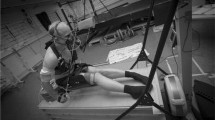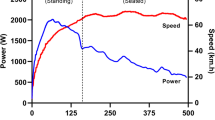Summary
The 100 m sprint race is run almost exclusively at the expenses of the phosphagen break-down which is the promptest and more powerful source of energy. This energy source is practically completely exhausted in this performance, thus providing about 120–150 cal/kg. An additional 40–50 cal/kg are provided by lactic acid formation from glycogen, and only about 10 cal/kg from oxidative processes. The energy necessary for speed maintainance may be not much more than 100–120 cal/kg, which is spent in performing an equal amount of positive and negative work. The energy necessary to accelerate the body amounts to about 60 cal/kg, while that to meet the wind resistance to about 40 cal. This is driven in part from an increase of the positive work performed, and for an appreciable fraction from a decreased negative work, taking place during the deceleration phase of the step cycle.
Similar content being viewed by others
References
Cavagna, G. A., R. Margaria, andR. Arcelli: A high-speed motion picture analysis of the work performed in sprint running. Res. Film5, 309–319 (1965).
—,F. P. Saibene, andR. Margaria: Mechanical work in running. J. appl. Physiol.19, 249–256 (1964).
— — —: Effect of negative work on the amount of positive work performed by an isolated muscle. J. appl. Physiol.20, 157–158 (1965).
Du Bois-Reymond, R.: Der Luftwiderstand des menschlichen Körpers. Pflügers Arch. ges. Physiol.208, 445–453 (1925).
Fenn, W. O.: Frictional and kinetic factors in the work of sprint running. Amer. J. Physiol.92, 583–611 (1930).
—: Work against gravity and work due to velocity changes in running. Amer. J. Physiol.93, 433–462 (1930).
Hill, A. V.: Muscular movement in man: the factor governing speed and recovery from fatigue. George Fisher Baker Lectures in Chemistry, vol. III. New York: MacGraw Hill Book Company 1927.
Margaria, R.: Sulla fisiologia e specialmente sul consumo energetico della marcia e della corsa a varie velocità ed inclinazioni del terreno. Atti. Reale Acc. Naz. Lincei7, 299–368 (1938).
Margaria, R.: Energy cost of sprint running. Proc. Int. Congr. Sport Sci. Tokyo 1964, p. 444.
—: Aerobic and anaerobic energy sources in muscles exercises. In: Exercise at Altitude, Ed.R. Margaria. Excerpta Med. Found. Amst. (1967).
—: Positive and negative work performances and their efficiencies in human locomotion. The Fifth Pan American Congr. on Sports Med., Winnipeg, July 24–25. Int. Z. angew. Physiol.25, 339–351 (1968).
—,P. Aghemo, andE. Rovelli: Measurement of muscular power (anaerobic) in man. J. appl. Physiol.21, 1661–1664 (1966).
—,P. Cerretelli, P. Aghemo, andG. Sassi: Energy cost of running. J. appl. Physiol.18, 367–370 (1963).
— —, andF. Mangili: Balance and kinetics of anaerobic energy release during strenous exercise in man. J. appl. Physiol.19, 623–628 (1964).
—,H. T. Edwards, andD. B. Dill: The possible mechanisms of contracting and paying the oxygen debt and the role of lactic acid in muscular contraction. Amer. J. Physiol.106, 689–715 (1933).
—,F. Mangili, F. Cuttica, andP. Cerretelli: The kinetics of oxygen consumption at the onset of muscular exercise in man. Ergonomics8, 49–54 (1965).
Sargent, R. M.: The relation between oxygen requirement and speed in running. Proc. roy. Soc. B100, 10–22 (1926).
Author information
Authors and Affiliations
Additional information
This paper was read at the Fifth Pan-American Congress on Sports Medicine, Winnipeg, Manitoba, July 24th–25th 1967.
Financially supported by the Italian National Research Council.
Rights and permissions
About this article
Cite this article
Margaria, R. Capacity and power of the energy processes in muscle activity: Their practical relevance in athletics. Int. Z. Angew. Physiol. Einschl. Arbeitsphysiol. 25, 352–360 (1968). https://doi.org/10.1007/BF00699625
Received:
Issue Date:
DOI: https://doi.org/10.1007/BF00699625




